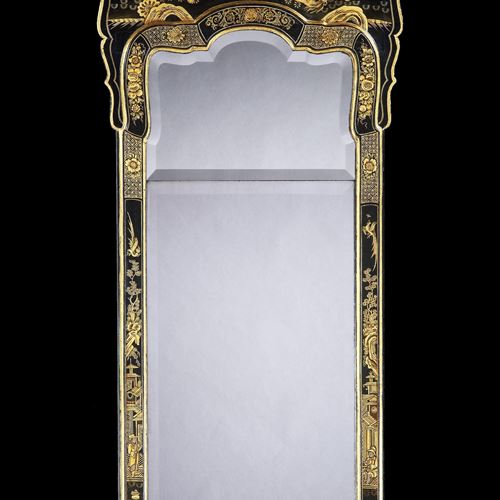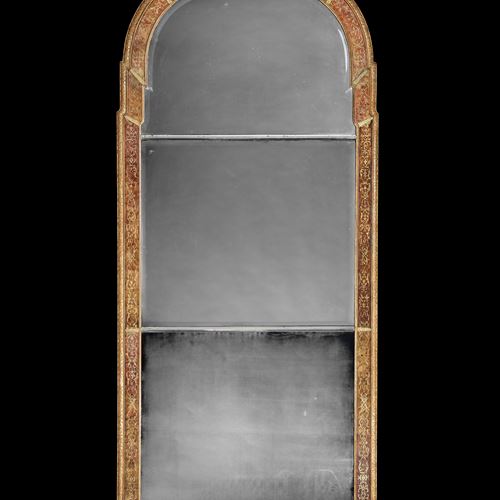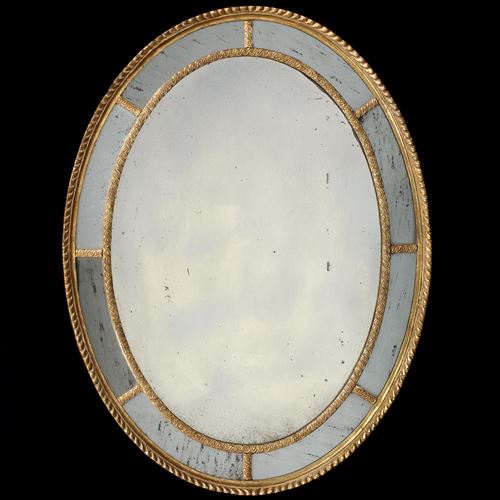search
1/3
A GEORGE III OVAL PIER MIRROR
england , circa 1765
A superb George III period giltwood pier mirror, the finely carved frame is outlined by an exuberant upward swirl of crossed scrolling acanthus leaves, extending up and crossing to form an asymmetric spiral and curve of finely carved leaves and curling foliage, incorporating naturalistic details including a seed head, bell flowers and fruits, the frame further ornamented withf six-petalled flower heads, a well carved ribbon tie accentuating the crossed acanthus branches beneath.
Original mirror plate. The whole highlighted by an exceptional gilded and richly burnished finish.
Original mirror plate. The whole highlighted by an exceptional gilded and richly burnished finish.
Stock number
AD.346
dimensions
More Details
Height: 48³/₈ in (123 cm)
Width: 27 in (68.5 cm)
Width: 27 in (68.5 cm)
The scrolling acanthus leaf, the key design of this outstanding mirror is seen to very similar effect in a drawing by John Linnell (1729-1796), from a volume of Linnell designs for furniture, interior decoration, and architectural fittings held at the V & A , Department of Engraving, Illustration and Design, E.312-1929. Linnell produced a number of designs for oval shaped pier-glasses.
John Linnell (1729-1796) was the son of the famous furniture maker William Linnell (ca. 1703-1763). Unlike most furniture makers, John Linnell gained a design education at the St. Martin's Lane Academy, which was founded by William Hogarth in 1735. In 1750, aged 21, he joined his father's firm as a designer. On his father's death in 1763, John Linnell took over the family firm. During his lifetime John Linnell produced high quality furniture, which rivalled that of other leading furniture makers such as Thomas Chippendale, John Cobb and William Ince and John Mayhew.
From the first half of the 18th Century, designs in furniture and interiors became much more varied and elaborate, celebrating the inspiration of rococo style with a lighter touch that incorporated swirling lines, natural motifs, and elegant flourishes. Mirrors were an important element in this evolution of ideas. It was now considered traditional to place a large mirror over a fireplace, known as an overmantel; and pier glasses, oval or rectangular, were used to hang between windows, being highly prized for their decorative qualities and their ability to reflect the light of strategically placed candelabra – giving depth and brilliance to any interior.
The word Rococo derives from the French rocaille, originally referring to decorative garden ornamentation like the shellwork or pebble inlay found most typically in the grottoes and fountains of grand gardens. Gradually the rococo evolved into charming, somewhat whimsical designs using motifs derived directly from nature, employing a lightness of touch and a deliberate lack of uniformity at times but consistently delighting in the aesthetics of natural elements.
The design of this mirror also relates to a pier mirror supplied by Thomas Chippendale to Edwin Lascalles for Harewood House and subsequently sold by the 7th Earl of Harewood at Christie's London, 10 April 1986, lot 80. What appears to be a manuscript design for this frame dating from circa 1765 is amongst the Chippendale drawings held at the Metropolitan Museum of Art, New York. See: I. Hall, 'Newly Discovered Chippendale Drawings relating to Harewood', Leeds Art Calendar, no. 69 (1971), pp. 5-17 and C. Gilbert, The Life and Work of Thomas Chippendale, London, 1978, p. 70, fig. 108, and p. 77, figs. 118-119.
John Linnell (1729-1796) was the son of the famous furniture maker William Linnell (ca. 1703-1763). Unlike most furniture makers, John Linnell gained a design education at the St. Martin's Lane Academy, which was founded by William Hogarth in 1735. In 1750, aged 21, he joined his father's firm as a designer. On his father's death in 1763, John Linnell took over the family firm. During his lifetime John Linnell produced high quality furniture, which rivalled that of other leading furniture makers such as Thomas Chippendale, John Cobb and William Ince and John Mayhew.
From the first half of the 18th Century, designs in furniture and interiors became much more varied and elaborate, celebrating the inspiration of rococo style with a lighter touch that incorporated swirling lines, natural motifs, and elegant flourishes. Mirrors were an important element in this evolution of ideas. It was now considered traditional to place a large mirror over a fireplace, known as an overmantel; and pier glasses, oval or rectangular, were used to hang between windows, being highly prized for their decorative qualities and their ability to reflect the light of strategically placed candelabra – giving depth and brilliance to any interior.
The word Rococo derives from the French rocaille, originally referring to decorative garden ornamentation like the shellwork or pebble inlay found most typically in the grottoes and fountains of grand gardens. Gradually the rococo evolved into charming, somewhat whimsical designs using motifs derived directly from nature, employing a lightness of touch and a deliberate lack of uniformity at times but consistently delighting in the aesthetics of natural elements.
The design of this mirror also relates to a pier mirror supplied by Thomas Chippendale to Edwin Lascalles for Harewood House and subsequently sold by the 7th Earl of Harewood at Christie's London, 10 April 1986, lot 80. What appears to be a manuscript design for this frame dating from circa 1765 is amongst the Chippendale drawings held at the Metropolitan Museum of Art, New York. See: I. Hall, 'Newly Discovered Chippendale Drawings relating to Harewood', Leeds Art Calendar, no. 69 (1971), pp. 5-17 and C. Gilbert, The Life and Work of Thomas Chippendale, London, 1978, p. 70, fig. 108, and p. 77, figs. 118-119.

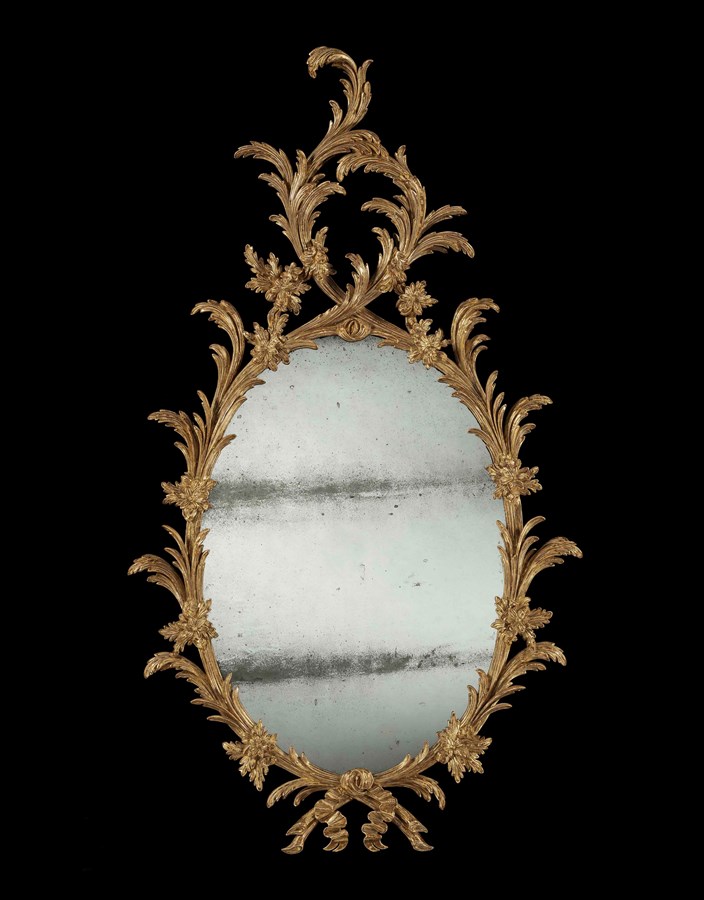
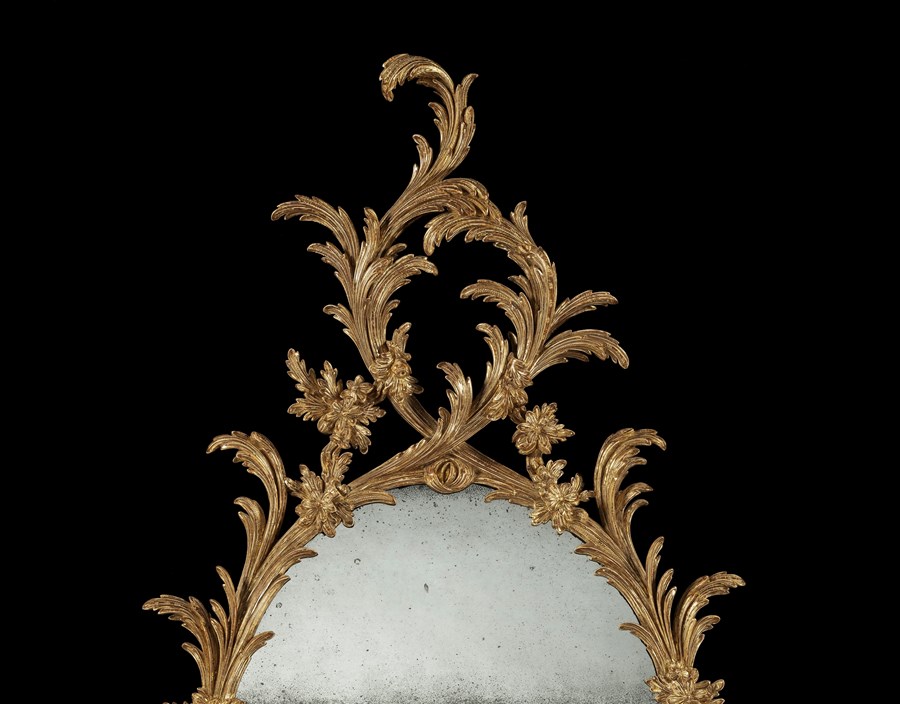
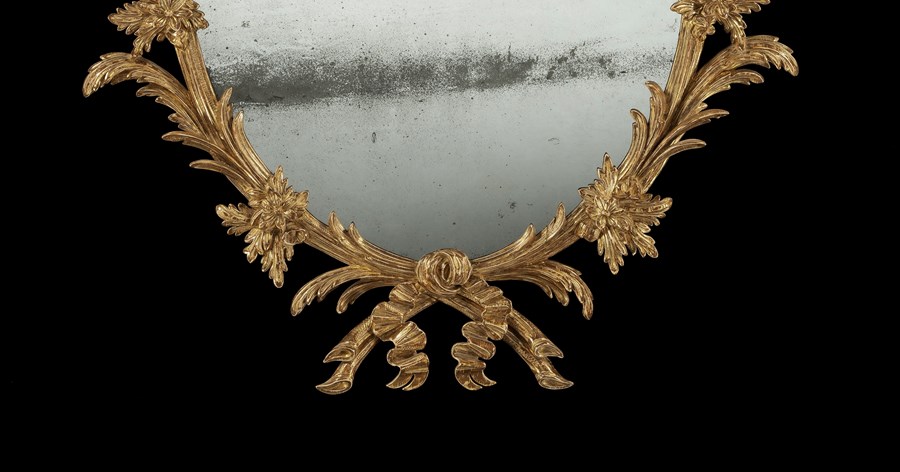


 enquire
enquire
 +44 (0)20 7839 5671
+44 (0)20 7839 5671
 +44 (0)7725 332 665
+44 (0)7725 332 665
